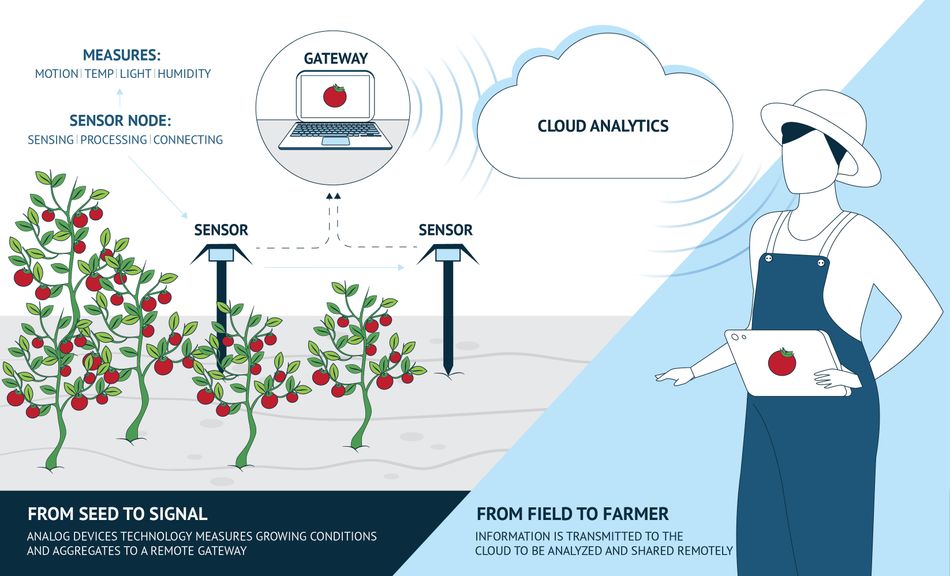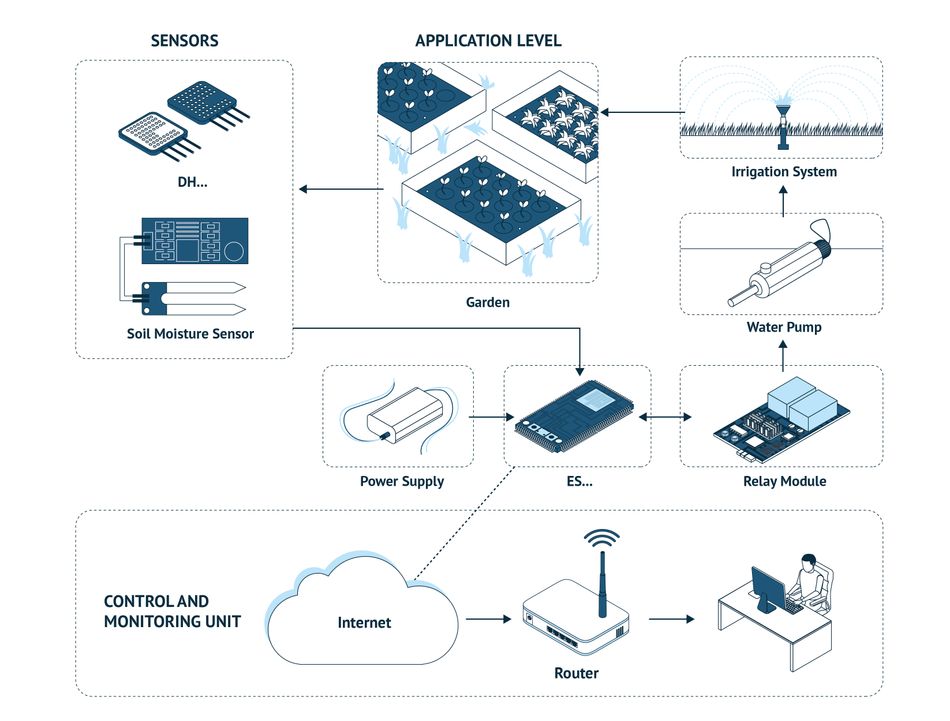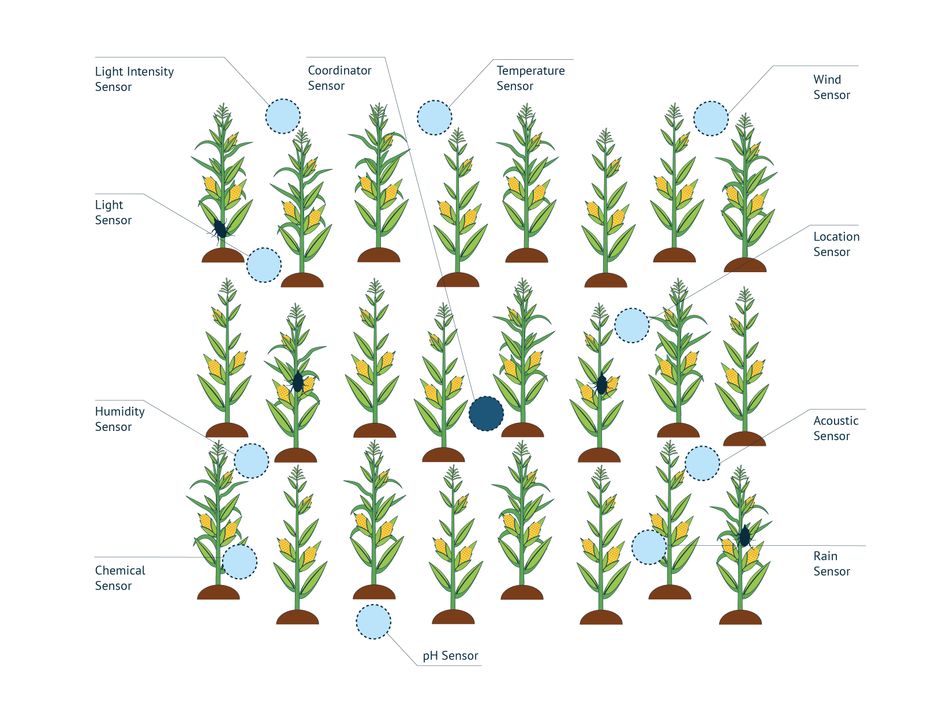Enabling the sustainable transformation of agriculture with the Internet of Things
A short guide to the technologies behind the next agricultural revolution.
With the urgency to prevent environmental degradation, reduce waste and increase profitability, farmers around the globe are increasingly opting for more efficient crop management solutions that are supported by optimization and controlling technologies derived from the Industrial Internet of Things (IIoT).
Intelligent information and communication technologies (IICT) (machine learning (ML), AI, IoT, cloud-based analytics, actuators, and sensors) are being implemented to achieve higher control of spatial and temporal variabilities [1] with the aid of satellite remote sensing. The use and application of this set of interconnected technologies are known as “Smart Agriculture” (SA).
In Smart Agriculture, real-time and continuous monitoring of weather, crop growth, plant physical/chemical variables, and other important environmental factors allow the optimization of yield production, reduction of labor, and improvement of farming products (See figure 1)[2]. Practices such as irrigation management, resource management, production, or fertilization operations are being facilitated by the integration of IoT systems that are capable to provide information about multiple crop factors (see Fig. 1). In this way, while quality and quantity of production are boosted, the negative aspects of unsustainable and costly agriculture practices are also prevented with advanced interconnected actuators and sensors.
Why Smart Agriculture?
In this relatively new field, the major focus is crop optimization through higher productivity and major control over environmental variations. SA provides a convenient way to integrate farming management by having in-hand mobile devices that receive data collected from Unmanned Aerial Vehicles (UAV), satellites, or wireless sensors that operate directly at the plant level and are connected for example to cloud-based systems. In general, SA can potentially:
- Reduce water consumption,
- Implement a better plant nursing process with optimized nutrient levels,
- Decrease risk of yield loss,
- Assurance of higher revenue,
- Better yield quality,
- Decrease overall production of waste,
- Simplification of labour,
- Enhance environmental protection.
Fundamentals
Usually, in SA-IoT ecosystems, the exchange of information occurs in web-based systems that operate at a rapid speed (see Figure 2). For example, ML integrated with multi-scale AI models is used to analyze weather dynamics to predict crop behavior [3]. Signals collected by multifunctional sensors are sent to a remote gateway for further analysis. Data is stored in cloud services that farmers can access away from the farming fields. Cloud analytics help the farmer to configure farming daily duties, responding faster to ever-changing and unpredictable environmental patterns and therefore, allowing better decision making.

Figure 3 suggests a fundamental configuration of IoT ecosystems that can be replicated for agricultural purposes. The set of elements representing the network makes use of sensors to collect data that is simultaneously captured via ML (see also Fig. 1) and actuators to obtain predictive information. In the physical layer, sensors interact with the environment while humans access data via mobile devices. In the network layer, 4G or 5G technology is used to transmit the data to cloud services. In the cloud section, tensor processing units (TPU) allow speeding computational analysis through the integration of AI, ML, and analytical libraries [4]. Such IoT systems can aid farmers to work remotely by making crop and animal management an automated process with reduced direct human intervention.

From small farming to urban gardening
The IoT can provide solutions for small farmers ranging from resource management to climate adaptability. However, urban gardeners or small producers are also benefiting from innovations brought through the evolution of IoT. Figure 4 shows a common low budget and high precision system [5] designed to improve irrigation in urban gardens. The system is rather simple, but it shows the potential easiness of building open-source solutions without major technical constraints in different setups where adaptation to environmental conditions is required. Basic electromagnetic sensors, power supply, a water pump, relays, and the irrigation system are hardware interconnected and managed via cloud-based monitoring. A control unit receives the data that is later accessed by the user via the internet.

The functionality of the system remains linked to scripted algorithms. With threshold values such as atmospheric temperature or soil moisture, a microcontroller can be fed to fulfill a specific function, such as irrigation [5]. The system permits optimization of limited gardening spaces while providing control of resources to increase plant quality or production yield.
Technology democratization can boost the competitiveness of small producers
Despite the tremendous potential of SA, technical issues are just one aspect of the whole story. The deployment of high-tech solutions, that are less costly, accessible, reliable, and durable has not yet reached maximum potential. The limited internet coverage in rural areas, especially in emerging economies slows down the deployment of SA technologies. It is why the democratization of IICT including the internet is not a discussion of privilege. It is a crucial step to support the sustainable transformation of agriculture in which small farmers and rural communities can also benefit from technological development.
To increase the adaptation of IIoT solutions, several options exist. Offering open access to quality tech solutions presents a potential route to democratize technological advances [6]. The proliferation of mobile connectivity options (e.g. LoRa WAN) and smart technology can support opening such processes to small producers (inclusive from remote locations) who could directly improve their farming experience and access new consumer niches. In the meantime, helping them to connect with investors and other partners. Therefore, facilitating communication between farmers and allowing sharing e.g., IoT projects and best practices.
Conclusion
In sum, this article has covered some of the basic principles of Smart Agriculture, including a description of the structure of fundamental IoT systems and the functional basic principles. In this exploration, an idea about the opportunities that IICT technologies bring to small producers was highlighted. The concept of smart technologies to support the sustainable transition of agriculture was explored. With the implementation of IoT solutions, it was mentioned that small farmers and producers can potentially make better use of their resources with interconnected technologies that can be developed with the use of open-source alternatives. This article just scratches the surface of the ways IIoT can enable positive change in the agricultural sector.
This article is the second in a series about IIoT. Read the first article; an engineer's guide to IIoT here.
About the sponsor: Arduino Pro
Arduino Pro, aiming to offer adequate solutions for different size companies that are looking to easily evolve their application platforms with the IoT. With a variety of alternatives such as Arduino Edge Control, remote monitoring and control of farming activities can be better managed in a variety of rough environmental settings. With its easiness to adapt to solar-based power supply, the Arduino Edge Control offers the power of AI with state-of-the-art connectivity modems. The Arduino Edge Control, as well as other devices, can be managed via the Arduino IoT Cloud.
Open source is trustworthy. Farmers can leverage ideas and support from a community of over 30 million users to begin to integrate Arduino components into their smart agriculture solutions. The range of connectivity options available to suit the local conditions along with the ability to process AI on the edge, thereby reducing the frequency and size of data transmitted to the Cloud, makes the Arduino Pro range particularly suited to SA.
The design team at Arduino Pro understands the need to move forward in industrial sectors with the commitment to gain major sustainability. For Smart Agriculture, the company offers a set of reliable, manageable, and cost-effective solutions. The evaluation of remote sensor-collected data can be done with Arduino Pro with the advantages that remote monitoring offers. Sensing weather data, soil conditions, and plant health can be improved with the new Arduino Pro solutions. With the Arduino Edge Control, the company aims to reduce effort, improve efficiency and sustainability with the automation of farming processes.

References
- Goel, R. K., Yadav, C. S., Vishnoi, S., & Rastogi, R. (2021). Smart agriculture – Urgent need of the day in developing countries. Sustainable Computing: Informatics and Systems, 30(January), 100512. https://doi.org/10.1016/j.suscom.2021.100512
- Cicioğlu, M., & Çalhan, A. (2021). Smart agriculture with internet of things in cornfields. Computers and Electrical Engineering, 90(January). https://doi.org/10.1016/j.compeleceng.2021.106982
- Kiran, S., Sandeep Kanumalli, S., Venkata Sesha Sai Rama Krishna, K., & Chandra, N. (2021). Internet of things integrated smart agriculture for weather predictions and preventive mechanism. Materials Today: Proceedings, xxxx. https://doi.org/10.1016/j.matpr.2020.11.081
- Idoje, G., Dagiuklas, T., & Iqbal, M. (2021). Survey for smart farming technologies: Challenges and issues. Computers and Electrical Engineering, 92(April), 107104. https://doi.org/10.1016/j.compeleceng.2021.107104
- Podder, A. K., Bukhari, A. Al, Islam, S., Mia, S., Mohammed, M. A., Kumar, N. M., Cengiz, K., & Abdulkareem, K. H. (2021). IoT based smart agrotech system for verification of Urban farming parameters. Microprocessors and Microsystems, 82(January), 104025. https://doi.org/10.1016/j.micpro.2021.104025
- Goap, A., Sharma, D., Shukla, A. K., & Rama Krishna, C. (2018). An IoT based smart irrigation management system using Machine learning and open source technologies. Computers and Electronics in Agriculture, 155(May), 41–49. https://doi.org/10.1016/j.compag.2018.09.040


